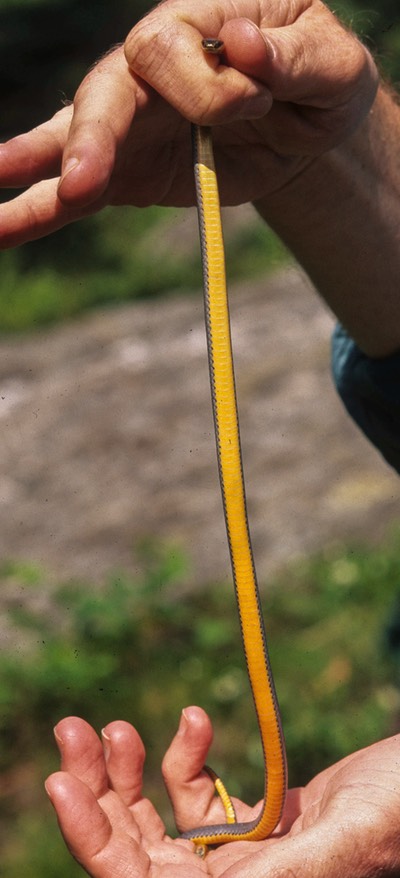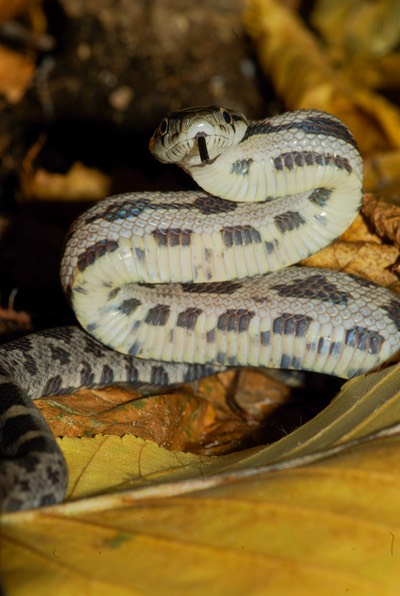Sometimes you may only see the underside of a snake!

Watersnake—Fabulous Belly Pattern
One of the unfortunate consequences of the last 100 year “progress” is the almost unbelievable increase in paved surfaces for use by automobiles, farm equipment, touring bikes, scooters, motorcycles, and more. There are 8,320 miles of roads in Western Massachusetts alone, divided into Federal, State, local, and private ways. Add to this the ever increasing driving speed (whether legal or not), along with the many devices vying for drivers’ attention, and it’s no wonder that over 1 MILLON tetrapods are killed on US roadways EVERY DAY (see here). Astounding, to say the least.
Snakes, of course, are commonly killed on roads. Some drivers actually target them. Snake remains are often visible for days after a snake is killed, even though many scavengers go after this new food source; scavengers themselves are sometimes hit and killed. The snake carnage goes on day and night, since some snakes are decidedly nocturnal while others are diurnal. A few crepuscular species become victims at dawn and dusk. Some snakes not only cross roads, but rest on the warm surface both day and night. In other parts of the country, herpetologists cruise roads specifically at night to survey snakes (hopefully still alive) and then move them to safety. Night driving to study snakes does not appear to be productive in New England, however.
As unsettling as it is to find a dead snake, remains can provide useful data on distribution, reproduction, age, color morphs, and genetics. Few herpetologists lack dead snake parts in their home freezers (sad, perhaps, but true enough). These specimens eventually make their way into research museums. More delicate field naturalists may prefer to photograph the squished snake and record data, which can still yield valuable information.
Some snakes have a decidedly different color a day or two after being flattened (in addition to the obvious alteration from 3 to 2 dimensions). Greensnakes, for some reason (possibly the micro structure of the scales), turn from emerald green to a blue tone. So, too, do Black Racers, especially during a shedding cycle. The first one I saw (at age 15) led me to incorrectly conclude it was a Blue Racer (Coluber constrictor foxi), a subspecies found in the upper Midwest of the US. It wasn’t, of course. For roadkills that are upside down or snakes you see in your skylight, check out these photos to help identify them.
Now for the good news. In some areas with high snake populations and progressive state agencies or active conservation groups roads are closed, at least in seasons when snakes are most active. In Florida, a major highway has been fitted with a safe passage constructed for snakes and other animals whose populations have suffered for decades. Look at some great video about reptiles on roads in Ontario from a pair calling themselves The Sticky Tongue Project (how cool is that). Click to get to the video titled: "Reptile Fencing". In Western Mass, the Berkshire Environmental Action Team works with with the Dept. of Transportation to ensure safer roads for wildlife, including snakes.
Conservation is rarely easy or simple, however. In the case of Florida's Paynes Prarie safe passage, the underpasses are working, but egg-laying snakes, according to local field herpetologists, are still faring poorly compared to the live-bearers. The explanation seems to be due to the activities of non-native fire ants, abundant on the raised shoulders of many roads in the southern US. The ants are known to invade the eggs of some reptiles while they are hatching; the young snake is unable to escape and is killed. Fire ant interactions are more complex and in some cases are able to kill small snakes, even of livebearers. Some adult snakes are susceptible to fire ant stings while other species or individuals apparently are not.

Fire Ant nest along a Florida state highway

Black Racer (juvenile). Adults show virtually no belly pattern.




